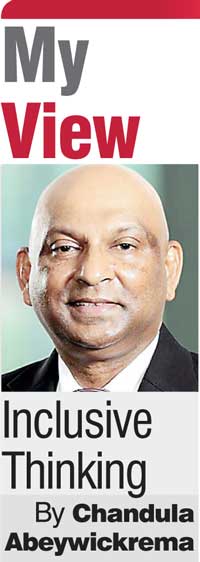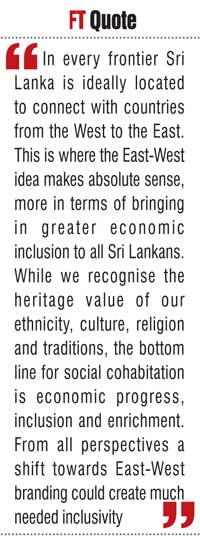Friday Jan 02, 2026
Friday Jan 02, 2026
Thursday, 25 June 2015 00:00 - - {{hitsCtrl.values.hits}}
Tyron Devotta hit the nail on the head with his article in the Daily FT, North-South brand against East-West brand, where he says that we have to move away from thinking the North-South equation and think on the lines of an East-West divide for the country. This is a timely observation and opens the floor for intellectual discussion.
The country has no doubt suffered in the last 50 years due to the ideological, social and cultural divide of created by north-south phenomenon. It has created false pride, arrogance, greater separation and division, religious and cultural animosity, and opened doors for power-hungry short-term-oriented politicians on both sides.
As Tyron has argued, should we continue to put economic enrichment on the backburner, while we wait to bridge the ingrained differences of the north and south or do we look at other options that we may have so far overlooked?
Particularly, the youth of the country deserve a much better future and it’s high time we went about ensuring it. From 1971 to 2009 the country faced three youth uprisings – two in the south and one in the north. Nearly 300,000 youth sacrificed their lives in demanding economic inclusion more or less, even though all three uprisings had political motivation and the youth were just a means to an end.
Capitalising on geographical location
Arguably, Sri Lanka’s geographical location is one of the best in the world. While many other powerful countries have taken  advantage of it, it is unfortunate that our political leaders didn’t have the vision to capitalise on that.
advantage of it, it is unfortunate that our political leaders didn’t have the vision to capitalise on that.
In every frontier Sri Lanka is ideally located to connect with countries from the West to the East. This is where the East-West idea makes absolute sense, more in terms of bringing in greater economic inclusion to all Sri Lankans. While we recognise the heritage value of our ethnicity, culture, religion and traditions, the bottom line for social cohabitation is economic progress, inclusion and enrichment.
From all perspectives a shift towards East-West branding could create much needed inclusivity. If we take the western half of Sri Lanka, it has ethnic, religious, cultural and social diversity and groups embedded; the eastern half too has a similar composition.
As mentioned by Tyron in his article, in comparison to the western part, which is more prosperous economically, the eastern half is a marginalised economically. Over the years the western part of Sri Lanka has gained the advantages of being a business hub, finance hub, educational hub, apart from the benefits of the country’s port and the airport locations. On the other hand the eastern part consist of naturally available land mass and a coastal belt with the best beaches, where one of the world’s best natural harbours in the world is located.
Much potential in the east
There is much potential in the eastern part of Sri Lanka for tourism and hospitality industry, scalable commercial agriculture, agro-based industries and services, transhipment assembly lines, manufacturing as well as vocational and technical education infrastructure build up.
This could create huge opportunities for employment generation, livelihood development, knowledge and technology transfer. While the people in the east half will directly benefit from this facilitation, the west too can derive significant spinoff benefits by becoming a service provider.
When you look at the challenging issues the country has faced in the last 50 years, it is mostly due to a lack of economic empowerment, enrichment related inclusion issues rather than, social, religious, cultural and ethnic issues. Therefore, economic prosperity, by and large, is what the people of this country need.
Youth uprisings
Looking back at the major setbacks the country has faced in the last 50 years, one of the first factors that clearly stands out is the unsuccessful 1971 southern youth uprising to topple the elected new government at the time. It is significant that the government had embarked on a “closed economy system” which slowed growth. In crushing this uprising the government had to use military means, and nearly 30,000 youth of the country lost their lives.
In 1988/99 the same southern youth group, initiated one of the most violent uprisings for the second time. The setback for the country from this uprising was unprecedented. The loss of national assets, public and private properties, business and economic setbacks and above all the loss of lives placed Sri Lanka behind some of its small regional neighbours in terms of prosperity and economic development. The number of young lives lost due to the uprising exceeded 100,000.
Thirdly, the 30-year-old ethnic war triggered by the LTTE, which caused the northern youth uprising was far worse than the southern youth uprising. It was 30 years opportunity lost for the country; instead of stepping towards becoming a regional economic power; multiple, social, cultural, religious, issues divided this once united nation into a people of hatred, violence and no regard for human life or social inclusivity.
Whatever the theories and arguments the pundits will come up with as to the cardinal reasons for the two southern youth uprisings and the far more deadly northern youth uprising, the bottom line is the issue of youth economic exclusion – starting with equal opportunities for, studies, public sector employment opportunities, etc.
East-West brand
It is in a setting like this, that we as the country as well as individuals, need to move away from the divisive North-South brand toward a more economically-inclusive East-West brand. Conceptualising, and creating a pragmatic economic framework which can harness the country’s natural resource, human capital and talent in particular towards the youth of the country would trigger a greater investment climate.
There would be increased opportunity for Sri Lanka’s private and public as well as international investors would become interested in investing in diverse projects not only connect the countries in the Western world to the countries in the Eastern world but also synchronising and harmonising west of Sri Lanka with east of Sri Lanka.
This would create the social inclusion the country needs, in terms of employment opportunities, social benefits, and the livelihood development of Sri Lankan society irrespective of their colour, creed or ethnicity.
This small island has to create equal opportunity through an inclusive social framework and the East-West brand just might be the way in which to achieve this.
[The writer is the Chairman of Asia’s largest microfinance network Banking With The Poor Network (BWTP). He is also the Chairman of CSR Sri Lanka, the national apex body for corporate social responsibility. Her serves on the boards of Sri Lankan and international financial institutions. He was appointed by Asian Bankers Association as its Special Advisor on Financial Inclusion. He is an innovator, advocate and practitioner of financial inclusion in Asia. He can be contacted at [email protected].]